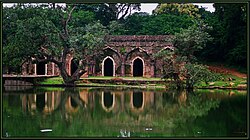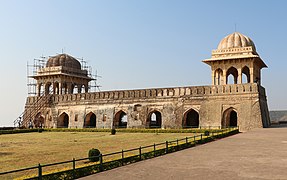
Malwa is an historical region of west-central India occupying a plateau of volcanic origin. Geologically, the Malwa Plateau generally refers to the volcanic upland north of the Vindhya Range. Politically and administratively, it is also synonymous with the former state of Madhya Bharat which was later merged with Madhya Pradesh. At present the historical Malwa region includes districts of western Madhya Pradesh and parts of south-eastern Rajasthan. Sometimes the definition of Malwa is extended to include the Nimar region south of the Vindhyas.

Burhanpur is a city in the Indian state of Madhya Pradesh. It is the administrative seat of Burhanpur District. It is situated on the north bank of the Tapti River and 340 kilometres (211 mi) southwest of the state's capital city of Bhopal. The city is a Municipal Corporation.
Dhar is a city located in Dhar district of the Malwa region in the state of Madhya Pradesh, India. The city is the administrative headquarters of the Dhar district. Before Indian independence from Great Britain, it was the capital of the Dhar princely state.

Mandu or Mandavgad is an ancient city in the present-day Mandav area of the Dhar district. It is located in the Malwa and Nimar region of western Madhya Pradesh, India, at 35 km from Dhar city. In the 11th century, Mandu was the sub division of the Tarangagadh or Taranga kingdom. This fortress town on a rocky outcrop about 100 km (62 mi) from Indore is celebrated for its architecture.

Mehrauli is a neighbourhood in South Delhi, a district of Delhi in India. It represents a constituency in the legislative assembly of Delhi. The area is close to Gurgaon and next to Vasant Kunj.

Dilawar Khan Ghori was an Afghan governor of the Malwa province of central India and laterly Sultan of the Malwa Sultanate during the decline of the Delhi Sultanate. After serving at the court in Delhi, he was appointed governor at Dhar in A.H. 793/C.E. 1390–91. Dilawar Khan took the title of 'Amid Shāh Dā'ūd and caused the khutba to be read in his name in A.H. 804/C.E. 1401–02. He passed his kingdom – the Malwa Sultanate – to his son Hoshang Shah upon his death in A.H. 809/C.E. 1406.

Bayazid Baz Bahadur Khan was the last Sultan of Malwa Sultanate, who reigned from 1555 to 1562. He succeeded his father, Shuja'at Khan. He is known for his romantic liaison with Roopmati.

Rani Roopmati was a poet and the consort of the Sultan of Malwa, Baz Bahadur. Roopmati features prominently in the folklores of Malwa, which talk about the love between the Sultan and Roopmati. Adham Khan was prompted to conquer Mandu partly due to Roopmati's beauty. When Adham Khan marched on the fort Baz Bahadur met him with his small force and was defeated, Roopmati poisoned herself. Thus ending the magical love story which was steeped in music, poetry, romance, war and death. This romance is considered a legend by some whilst others consider it to be true. Mandu is 100 KM from Indore.
Barwaha is a municipality and tehsil in Khargone district in the state of Madhya Pradesh, India. Barwaha is second biggest city of District after Khargone city.The Barwaha city is divided into 18 wards for which elections are held every 5 years. The Barwaha Municipality has population of 39,973 of which 20,940 are males while 19,033 are females as per report released by Census India 2011. Literacy rate of Barwaha is 87.27% higher than state average of 69.32%. In Barwaha, Male literacy is around 92.73% while female literacy rate is 81.23%.
Dharampuri is a town and headquarters of a tehsil in Dhar district in the state of Madhya Pradesh, India. It is situated on banks of river Narmada. It is a place of some historical and archaeological interest.
Sarangpur is a city and tehsil in Rajgarh district in the Indian state of Madhya Pradesh. It is situated at the bank of the river Kali Sindh.
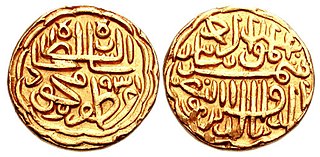
Shams-ud-Din Muzaffar Shah II or Muzafar II, born Khalil Khan, was a Sultan of the Muzaffarid dynasty, who reigned over the Gujarat Sultanate from 1511 to 1526. He was the eldest son of Sultan Mahmud Begada.

The Malwa Sultanate was a late medieval sultanate in the Malwa region, covering the present day Indian states of Madhya Pradesh and south-eastern Rajasthan from 1392 to 1562. It was founded by Dilawar Khan, an Afghan governor of the Delhi Sultanate. Dilawar Khan had ceased to pay tribute to Delhi after 1392. Following Timur's invasion and the disintegration of the Delhi Sultanate, in 1401/2, Dilawar Khan made Malwa an independent realm.
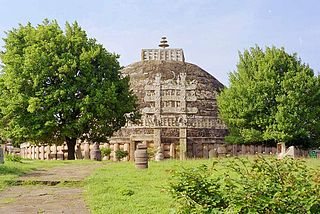
Tourism in Madhya Pradesh has been an attraction of India because of its location in the centre of the country. Madhya Pradesh has won Best Tourism State National award for 3 consecutive years i.e. 2017, 2016 and 2015.

The Farooqi dynasty was the ruling dynasty of the Khandesh Sultanate from its inception in 1382 till its annexation by the Mughal emperor Akbar in 1601. The founder of the dynasty, Malik Ahmad participated in a rebellion against the Bahmani ruler Muhmmad Shah I in his early years. When he was compelled to flee from Deccan, he established in Thalner on the Tapti River. After receiving the grant of the fiefdoms of Thalner and Karanda from Firuz Shah Tughluq in 1370, he conquered the region around Thalner, which later became known as Khandesh. By 1382, he started ruling independently.

The Hindola Mahal, is a large meeting hall, or durbar, in the ancient Indian city of Mandu, Madhya Pradesh. Today the Hindola Mahal is a tourist destination in the ruined city.
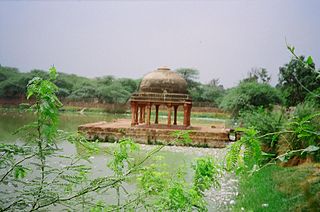
Hauz-i-Shamsi also called Shamshi Talab is a water storage reservoir or tank built by Iltutmish of the Slave Dynasty in 1230 CE, at a location revealed to him in a dream by the Islamic prophet Muhammad. A palace called the Jahaz Mahal was built on the eastern edge of the same reservoir during the Lodi dynasty period in the 16th century as a retreat or Inn for use by pilgrims. Also at the edge of Hauz is the tomb of 17th-century Persian writer in the Mughal court, Abdul-Haqq Dehlavi. The monuments are situated in Mehrauli, Delhi.

Jahaz Mahal, is located next to Hauz-i-Shamsi in Mehrauli, Delhi on its northeastern corner. It was so named, since its reflection (illusion) in the surrounding reservoir looked like a ship floating on a lake. It is inferred to have been built during the Lodi dynasty period (1452–1526) as a pleasure resort, Sarai or an inn.

Jama Masjid is a historic mosque in Mandu in the Central Indian state of Madhya Pradesh. Built in Mughal style of architecture, the mosque has been believed to have been built during the reign of Hoshang Shah and completed during the reign of Mahmud Khilji in 1454.
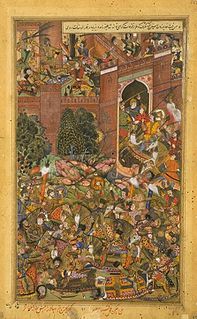
The Mughal conquest of Malwa was a military campaign launched by the Mughal Empire in 1560 during the reign of Akbar against the Sultanate of Malwa, which had broken free from Mughal rule during the rebellion of Sher Shah Suri from the emperor Humayun. Thus, Akbar had a claim to the province. Baz Bahadur had been the governor of Malwa in the Sur Empire but broke away after the death of Sher Shah.

